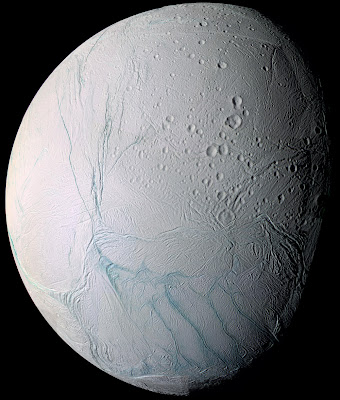 |
| False colour image of Saturn's moon Endceladus, showing four
pronounced "tiger stripes", which appear blue, in the southern
hemisphere. Image Credit: NASA/JPL/Space Science Institute |
The distinctive colour of these tiger stripes shows that their composition is different from the surrounding terrain. It is believed that the stripes are "blue" because they have not been covered by fine-grained water ice particles from Saturn's E ring, in which Enceladus orbits. This would suggest that the tiger stripes must be very young, possibly less than 1000 years old!
Furthermore, data from the Cassini mission to Saturn indicates that these stripes are very hot (minus 135 degrees Fahrenheit) relative to the surrounding regions (minus 330 degrees Fahrenheit). Temperature maps from the Composite Infrared Spectrometer (acquired in March 2008) show that the hottest regions line up with the tiger stripes. Heat, must therefore be escaping from Enceladus' interior along these fractures.
 |
| The heat map of Enceladus' "tiger stripes", overlain on visible
image data, shows that heat is escaping the planet from these
fractures. Image Credit: NASA/JPL/GSFC/SwRI/SSI |
Most spectacularly, plumes of vapour and ice particles have been observed jetting from the hottest parts of the tiger stripes. These plumes consist predominantly of water, with small amounts of methane, carbon monoxide, carbon dioxide and other simple and complex organics, making them similar to comets in composition. Furthermore, it is thought that the whole of Saturn's E ring has been made from these particles that were spewed from Enceladus. The discovery of these jets in November of 2005 added Enceladus to the very short list of places in the Solar System where active volcanoes have been observed.
| False-colour image of individual jets emanating from the
surface of Saturn's moon Enceladus. These plumes consist mostly of water
vapour and ice particles, with traces of other organic compounds. Image Credit: NASA/JPL/Space Science Institute |
However, not all the plumes are neatly associated with the 4 named tiger stripes. A poster presentation by Patthoff and Kattenhorn at the recent Lunar and Planetary Science Conference suggests that current plume activity could be coming from older fracture sets.
The currently named tiger stripes are just the most prominent and youngest set of such fractures. Older sets of fractures, which look very similar to the current tiger stripes, have also been identified. These are termed ancient tiger stripes. It is suspected that, in their day, ancient tiger stripes probably behaved similarly to the current tiger stripes, but then became less active as new stripes formed. This suggests that the south polar terrain of Enceladus has had a long history of tiger stripe activity, with a rotating series of fractures that continuously maintain Saturn's E ring.
What Patthoff and Kattenhorn did was calculate the diurnal stresses on Enceladus as it orbits Saturn, to see which stripes were under tension (being pulled apart) and which were under compression (being squeezed) at the time the plumes were observed. It is expected that stripes that are being squeezed together should not produce plumes, while those that are being pulled apart would allow materials to jet from the interior. The Patthoff and Kattenhorn model shows that for some plume events, the nearby current tiger stripes were under compression (being squeezed), while certain ancient tiger stripes were under tension (being pulled apart). They therefore conclude that the tidal stresses caused by Enceladus orbiting around Saturn may allow ancient tiger stripes to be re-activated and produce plumes even after younger stripes have developed.
Enceladus continues to astound us!
Sources:
Planetary Society Hangout: Ice Giants with Heidi Hammel
Patthoff and Kattenhorn, 2013, The contribution of ancient tiger stripes to plume activitiy and energy flux on Enceladus, LPSC 44, Abstract #1675.
No comments:
Post a Comment